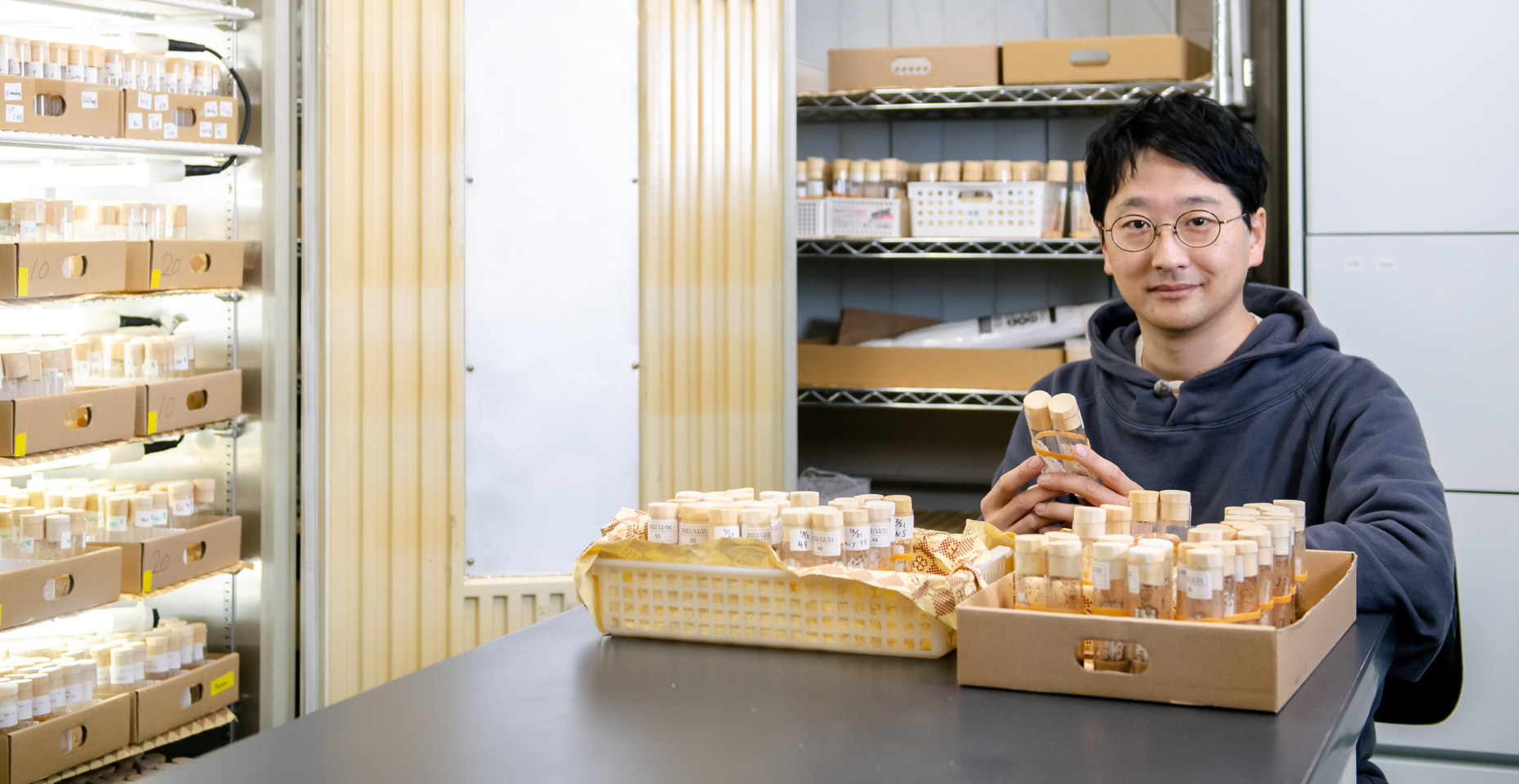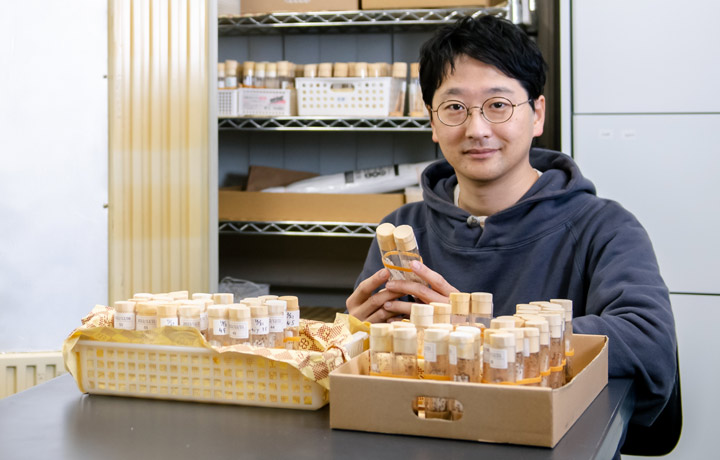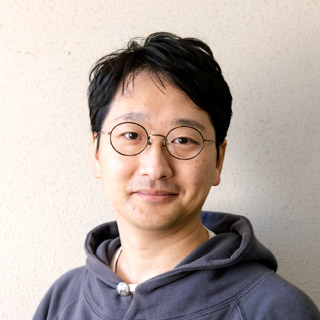Associate Professor Yuma Takahashi from the Graduate School of Science, renowned for his expertise in borderless ecology, sociology, and design, envisions a society where diversity is valued through the study of living organisms.
His exceptional research approach has garnered high acclaim, earning him the Chiba University Award for Distinguished Researcher in 2022. In addition, his book and lectures on ‘Basic Design Rule’ have gained recognition, offering guidance to researchers struggling with proposal creation. I had the opportunity of gaining insight into his mindset.
A world of insects in search of originality
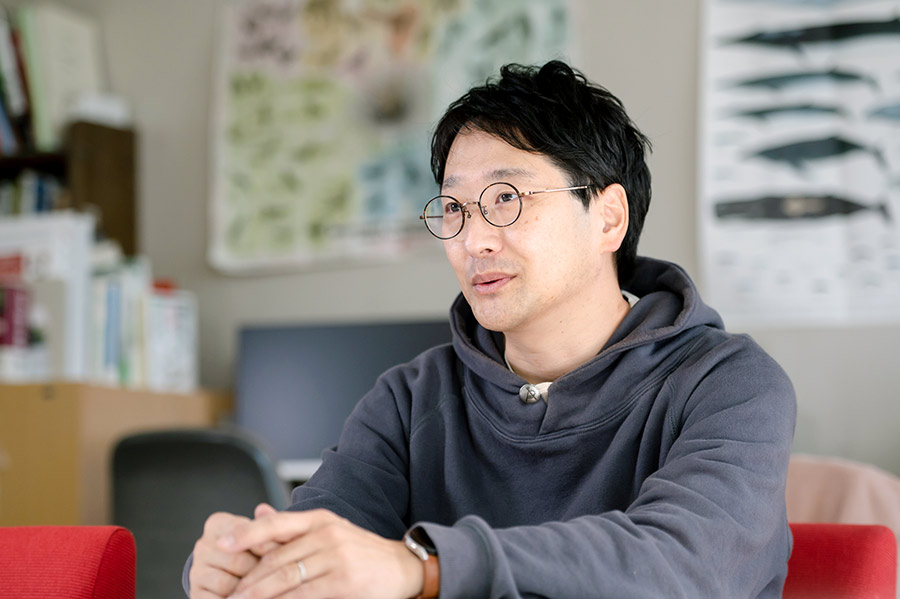
The soft sunlight streaming through the window gently illuminates the lush foliage plants, while the walls are adorned with carefully arranged textile boards, creating a rhythmic display. The ambiance is reminiscent of a charming Scandinavian boutique rather than a typical research laboratory. Despite being a scientist in the field of ecology, he carries himself with the flair of an art professor.
I spent my leisurely childhood in Musashino City, Tokyo, attending an elementary school that was slightly distant from my neighborhood. Without any friends nearby, I often found myself daydreaming, folding origami, and playing string games by myself, both amidst nature and at home.
For some reason, only two club activities were available in my senior years: the football club and the insect club. As it was right after the establishment of the J-League, everyone chose football. However, I joined the insect club because I didn’t want to be like everyone else. There, I met a club advisory teacher who was incredibly knowledgeable about insects and introduced me to a world I had never known. This was the starting point for my career choice.
When I became a junior high school student, I wanted to share the fascinating world of insects with others. I, therefore, applied for a research contest focusing on dragonflies. However, despite my efforts, I didn’t receive any awards. Upon reflection, I realized that my project lacked the elements necessary to capture the attention of the judges.
Continuously searching for research that would captivate and inspire others, I finally won an award for the culmination of my dragonfly research that I published in my first year of high school. It was at this pivotal moment that I solidified my decision to pursue a career as a researcher, driven by my deep passion for making a difference in this field.
The emergence of a unique researcher with expertise in design theory
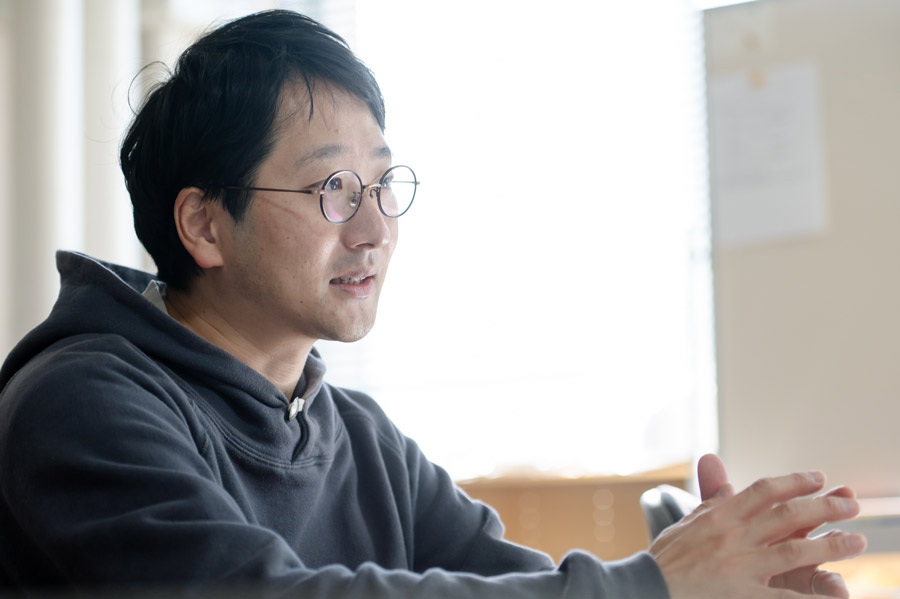
He decided to pursue a career as a researcher but didn’t want to study just for entrance exams. That’s when he discovered the self-recommendation-type entrance exam system at the University of Tsukuba. With the opportunity to showcase his dragonfly research, he successfully secured admission. This is where he further highlighted his individuality. He gained knowledge in the fields of typography and others to have the privilege of becoming a rare talent in the intersection of biology and design.
At that time, the University of Tsukuba required students to select some credits from other faculties, so I enrolled in several art-related subjects. With my parents working in the field of architecture, I had always been aware of the importance of creating detailed figures and graphs. The design was a familiar concept to me.

Dragonflies remain the research theme once again, showing how much he liked them.
Not exactly. Initially, I wanted to conduct research on a wide range of living organisms, so I planned to postpone deciding on a specific research theme until the very end. However, as fate would have it, a professor specializing in dragonfly research joined the university at the same time as my enrollment. Consequently, I end up dedicating approximately ten years of my research journey to studying dragonflies, starting from my undergraduate research. This extensive experience greatly influenced and shaped my current research style.
After that, he became a visiting researcher at Lund University in Sweden to conduct comparative research on dragonflies. There, he witnessed firsthand the excellent research environment.
I was deeply impressed by the work culture at the university, which prioritized spending time with family. It was remarkable to see that everyone would come home around 3:00 pm, have meals with their families, and put their children to sleep. The strong sense of teamwork enabled rapid progress in research, and the speed at which papers were written was truly impressive. The overall research performance was outstanding. This experience made me realize the importance of achieving a work-life balance that nurtures both personal and professional aspects of life.
Believe in yourself firmly, while embracing a balanced level of self-doubt
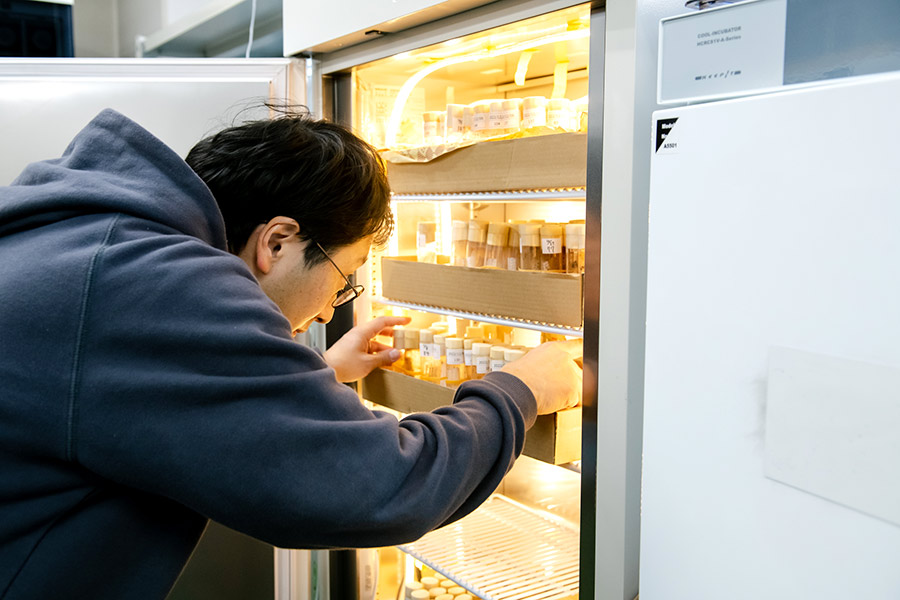
After assuming a position at Chiba University, he started full-fledged research on flies, which are easier to rear and study compared to dragonflies. Through the lens of biological diversity, he examines the entirety of society, including us humans. How did he acquire such a unique perspective?
My perspective isn’t as sharp as others, so I can’t compete with people who are digging deep into that field. Therefore, I strive to avoid being too confined to a single discipline and, instead, maintain connections to broader fields beyond biology. I am constantly conscious of viewing things from those perspectives. As a result, my research naturally expands and diversifies, much like the spread of a spider’s thread.
“I intentionally view events from a different perspective, recognizing that there can be no discovery if we all see things the same way.” Throughout the interview, he repeated this idea, expressing it with varying words each time.
I try to maintain the mindset that there must be something in common somewhere. By having a broad and shallow knowledge of various subjects and mentally connecting my research theme and data online, I find points of intersection with research in different situations. For example, when I saw the news that looking at a smartphone before going to bed affects sleep, I pondered how insects and plants might be affected. This idea led to a research study comparing urban and rural flies, which revealed that urban flies had undergone evolutionary adaptations to adapt their lifestyle patterns to the urban environment.
Phenomena that occur only under specific circumstances cannot always be applied to other fields. The pursuit of generality is crucial in research because it allows for broader applicability and understanding.
He cherishes something important when examining data
Theories and principles in ecology are rarely proven with such undeniable clarity through experimental or analytical data. We conduct experiments based on our own hypotheses and carefully analyze the data while embracing our imaginative thinking. This aspect of imagination is what makes ecology fascinating, but it also carries the risk of drawing incorrect conclusions. It is crucial to approach the phenomenon of life with strong convictions while maintaining a healthy level of self-doubt. Finding the right balance is very important.
Diversity thrives in an environment where minorities have equal access to opportunities
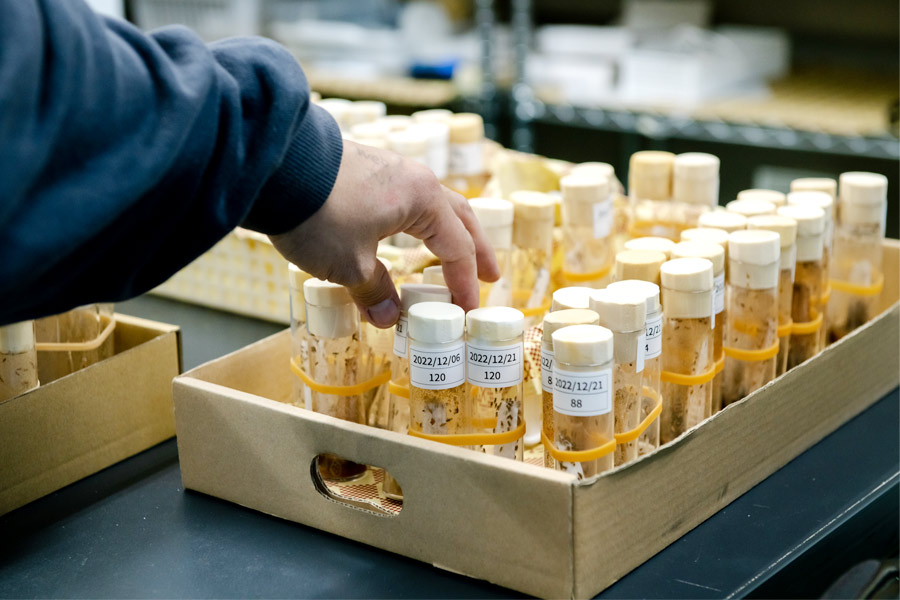
Just like choosing the insect club in elementary school, I have deliberately pursued a path that is different from others. Being in the minority gives me a sense of excitement and a unique perspective.
Gradually, he started paying more attention to the minority in living organisms, and a whole new world unfolded before him. In the realm of reproduction, which is the main event for organisms, there are instances where being in the minority can provide an advantage.
For example, in the dragonfly species called Ischnura senegalensis, all males have the same blue-green appearance, while females come in two types: brown and blue-green. When studying the reproductive behavior of this species, it was discovered that the minority brown females face less interference during reproduction.
In the world of a living organism, there are always males harassing females. However, in this species, the minority is not as preferred by males, resulting in fewer disruptions during reproduction and allowing them to leave behind a larger number of offspring. In other words, the existence of minorities contributes to the maintenance of the population size.
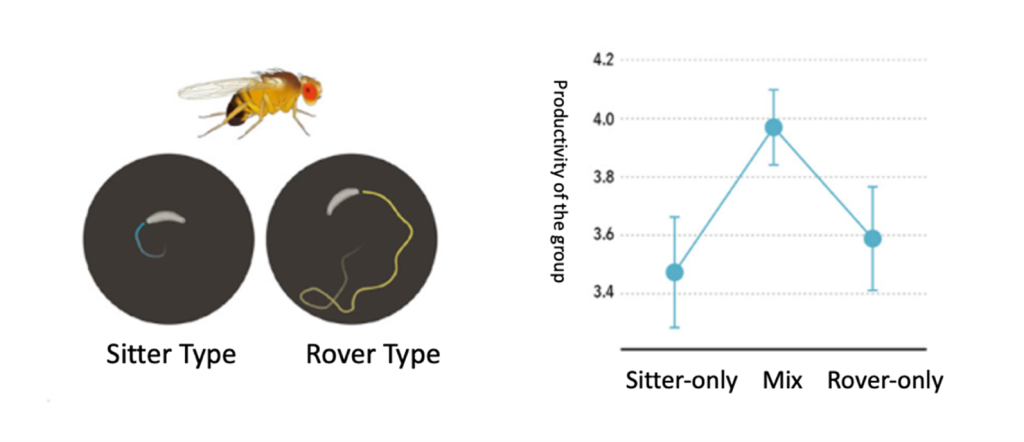
Also, in a study of fruit flies, we discovered that the diversity of individuality has a positive impact on the productivity and stability of a group. Fruit flies exhibit two types of behaviors: “sitters” (individuals that remain relatively stationary while searching for food) and “rovers” (individuals that actively move around in search of food). We conducted experiments under three conditions: “sitter-only,” “rover-only,” and a mixture of “sitters and rovers” to compare the productivity of the groups in terms of survival rates and overall weight.
The results revealed that the group with a mixture of sitters and rovers had the highest productivity. This finding highlights the importance of diversity in enhancing the performance of a group.
We are now mixing a greater variety of strains with diverse traits to investigate which combinations contribute to enhancing the productivity of the group at the genetic level.
As the research progressed further, it was found that diversity had a negative impact on the group when the minority was in a disadvantageous environment
From the interaction of diversity, innovation emerges, but equity is also crucial in this process. If both minorities and majorities have equal access to services and opportunities to engage, society could potentially progress in a more positive direction. While it is not as simple as directly applying insect research to humans, I believe there may be similar mechanisms at play.
We are now starting new research to explore if we can apply this idea to industries such as agriculture, engineering, and food and energy issues. One of our endeavors involves designing new microorganisms or crops by combining various varieties of beneficial microorganisms and crops to achieve higher yields and faster growth. Currently, we are studying the dynamics of yeast, which is essential in bread-making and sake brewing. We are also planning experiments to mix different varieties or strains of useful crops.
Our previous research on efficient fly breeding may also contribute to the realization of “entomophagy.” The intriguing aspect of my research lies in the dynamic connections from the micro to the macro scale.
We are currently seeking enthusiastic and motivated students who are passionate about research, regardless of their specific field of interest. If you are eager to explore new frontiers and embark on an exciting research journey, we invite you to visit our laboratory’s website. It could be the gateway to a whole new world of possibilities for you.
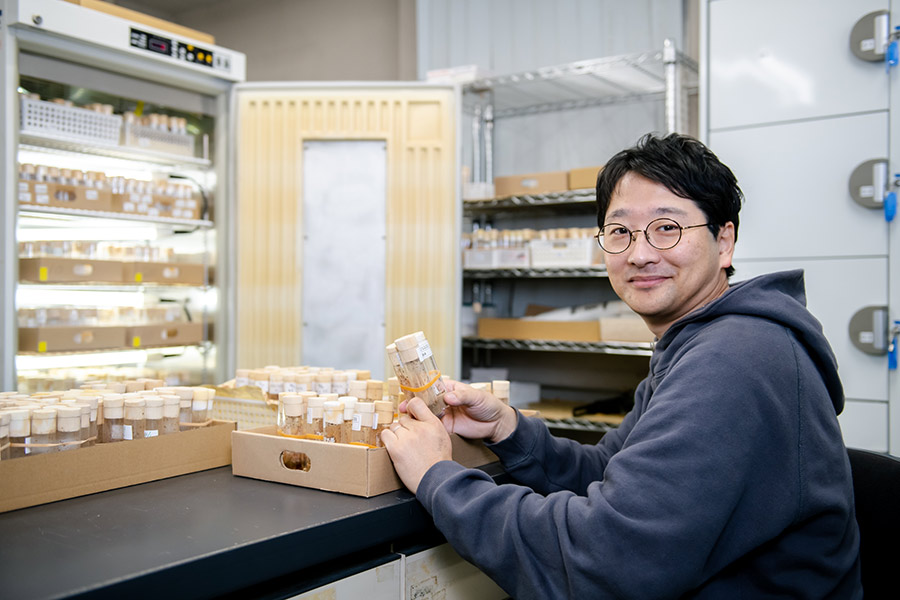
Recommend
-
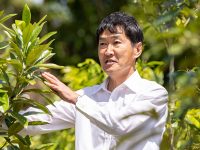
Towards a self-sustainable natural environment: The science of restoration ecology, where researchers engage in conversation with the earth
2023.02.02
-
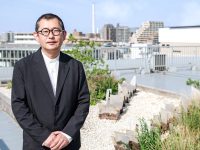
Creating Cities of Coexistence: Transitional Landscapes with the Tapestry of Diverse Lives
2024.02.09
-

Enigmatic Soliton Waves in Nature and Space: Demystifying Equations of Everyday Physical Phenomena
2023.12.04


